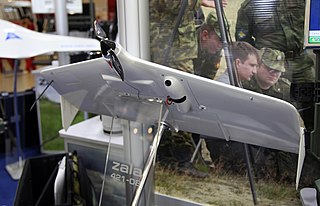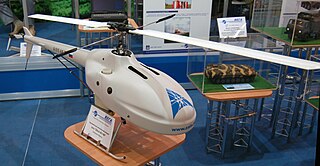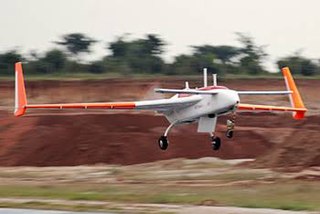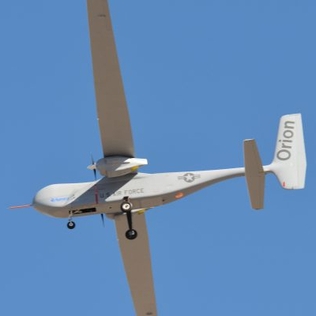
AeroVironment, Inc. is an American defense contractor headquartered in Arlington, Virginia, that designs and manufactures unmanned aerial vehicles (UAVs). Paul B. MacCready Jr., a designer of human-powered aircraft, founded the company in 1971. The company is best known for its lightweight human-powered and solar-powered vehicles. The company is the US military's top supplier of small drones —notably the Raven, Switchblade, Wasp and Puma models.

A miniature UAV, small UAV (SUAV), or drone is an unmanned aerial vehicle small enough to be man-portable. Smallest UAVs are called micro air vehicle.

The Northrop Grumman Bat is a medium-altitude unmanned air vehicle originally developed for use by the United States Armed Forces. Designed primarily as an intelligence "ISR" gathering tool, the Bat features 30 lb (14 kg) payload capacity that is unmatched in a 10 ft (3.0 m) wing span.
The Skyblade is a man-portable mini-UAV developed by ST Aerospace, designed to be used by two operators for short-range battlefield or tactical reconnaissance and artillery spotting.

The BAE Systems HERTI is an unmanned aerial vehicle (UAV) developed by the British company BAE Systems. HERTI stands for "High Endurance Rapid Technology Insertion" and was developed in Warton, United Kingdom. The HERTI airframe is based on the J-6 Fregata motor glider designed by Jaroslaw Janowski of J&AS Aero Design in Poland. Its first flight was in December 2004 at the Australian Woomera test range where much of the test flight programme has been undertaken. HERTI was also the first UAV to fly in the UK with the flight being certified by the Civil Aviation Authority.

ZALA 421-08 is a micro air vehicle developed and produced by the Izhevsk-based ZALA Aero company. It is a small, portable UAV platform. Weighing 9 kg, it includes 2 aerial vehicles, compact ground control station, 2 spare power supply kits and a backpack container used for transportation. ZALA 421-08 is designed for front-line reconnaissance, overground and oversea surveillance. It takes 3 minutes to prepare ZALA for launching. The UAV is operated in autonomous or semi-autonomous mode.

The ZALA 421-06 is an unmanned aerial vehicle helicopter designed and produced by Izhevsk-based ZALA Aero. This helicopter was developed in 2007–2008. In June, 2008 ZALA 421-06 was transferred to Russian Ministry of the Interior. This UAV can fly by program and in manual mode.

The DRDO Rustom is a medium-altitude long-endurance unmanned air vehicle (UAV) being developed by Defence Research and Development Organisation for the three services, Indian Army, Indian Navy and the Indian Air Force of the Indian Armed Forces. Rustom is derived from the NAL's LCRA developed by a team under the leadership of late Prof Rustom Damania in the 1980s. The UAV will have structural changes and a new engine.

The AeroVironment Wasp III Small Unmanned Aircraft System is a miniature UAV developed for United States Air Force special operations to provide a small, light-weight vehicle to provide beyond-line-of-sight situation awareness. The aircraft is equipped with two on-board cameras to provide real-time intelligence to its operators. It is also equipped with GPS and an Inertial Navigation System enabling it to operate autonomously from takeoff to recovery. It was designed by AeroVironment Inc., and was first added to the Air Force inventory in 2007. There are two Wasp variants: the traditional version that lands on land, and a version that lands into the sea or fresh water. The Air Force accepted the Wasp AE in late May 2012, and the U.S. Marine Corps revealed in January 2013 that they had ordered the Wasp AE. The Wasp AE is designated as the RQ-12A.

The AeroVironment T-20 unmanned aerial vehicle (UAV) is a medium range, composite aircraft capable of internal and external payloads. Launched from a portable catapult, it can be recovered with a shipboard landing system, or belly land on unimproved surfaces. The T-20 carries a retractable gimbal-mounted, digitally stabilized, electro-optical/infrared (EO/IR) camera that relays video in real time via a C-band LOS data link to the ground control station (GCS). Powered by a 4-stroke, fuel injected gasoline engine, the aircraft burns 2 lb (910 g) of fuel per hour at cruise. AeroVironment, Inc. acquired Arcturus UAV, the original developer of JUMP 20 and T-20 on February 22, 2021.
Jasoos is an unmanned aerial vehicle designed and manufactured by SATUMA of Pakistan. The Jasoos II Bravo+ variant is currently operational with the Pakistan Air Force.
ZALA Aero Group is a Russian company specialising in unmanned aerial vehicle (UAV) development, located in Izhevsk, Russia. ZALA Aero has provided UAV systems for several sectors of the Russian government, including the Ministry of Defence, and has also won contracts to supply UAVs to foreign countries. The company's in-house design and production projects include a variety of systems related to UAV design, manufacture and operation, including autopilots, airframes, mechanical and pneumatic catapults, launchers, payloads and communication technologies. ZALA Aero is the only Russian company producing unmanned helicopters, portable anti-drone EW systems and a VTOL drone.

The BPL Pegaz 011 is a tactical unmanned aerial vehicle prototype developed at the Military Engineering Institute, premiered at the 2011 Partner Arms Fair.
The Imperial Eagle is an Indian light-weight mini-unmanned aerial vehicle (UAV) developed by the Aeronautical Development Establishment, National Aerospace Laboratories and supported by private vendors. Its primary users will be the National Security Guard and the military services.

TAI Gözcü is a radio-controlled short-range tactical drone. Designed, developed and built by Turkish Aerospace Industries (TAI), the unmanned aerial vehicle (UAV) is in use by the Turkish Armed Forces for intelligence, surveillance, target acquisition and reconnaissance purposes. Gözcü is the Turkish word for observer.

The HESA Hamaseh is an Iranian tactical and reconnaissance unmanned aerial vehicle (UAV) with high flight endurance built by Iran Aircraft Manufacturing Industrial Company (HESA). The Hamaseh was unveiled in 2013 and entered service in 2016.

The Orion is a Medium-altitude long-endurance unmanned aerial vehicle (UAV) developed by Aurora Flight Sciences.

The LAPAN LSU-03 is an developed by the Lembaga Penelitian dan Penerbangan Nasional (LAPAN) of Indonesia. It is a further development of LAPAN LSU-02, and both are classified as a tactical UAV. While it is basically a further development of LSU-02, LSU-03 can achieve maximum range about 133% of its predecessor and significantly more payload.
The Shahpar-ll is an unmanned combat aerial vehicle (UCAV) built by Global Industrial Defence Solutions of Pakistan. It is currently in production following the completion of a test and qualification phase.














